The LG G4 Review
by Joshua Ho on July 30, 2015 10:00 AM EST- Posted in
- Smartphones
- Qualcomm
- LG
- Mobile
- Snapdragon 808
- LG G4
Snapdragon 808
In configuring the G4, LG (and recently Motorola) have broken away from the pack in terms of SoC choice, electing to use Qualcomm’s Snapdragon 808. This makes the G4 the first flagship phone to launch with the 808 as its SoC, and the first phone overall that we have reviewed with the 808 as well.
For those that are unfamiliar with this SoC, I would refer to our previous coverage on the Snapdragon 808. In short, the Snapdragon 808 is effectively a simpler SoC than the Snapdragon 810, with two CPU cores on the big cluster instead of four, a more mature LPDDR3 memory controller, a smaller GPU, and some general reduction in features and complexity in some aspects like the ISP and video encode blocks.
| Qualcomm's Snapdragon 810 and 808 | ||||
| Snapdragon 810 | Snapdragon 808 | |||
| Internal Model Number | MSM8994 | MSM8992 | ||
| Manufacturing Process | 20nm | 20nm | ||
| CPU | 4 x ARM Cortex A57 + 4 x ARM Cortex A53 (big.LITTLE) | 2 x ARM Cortex A57 + 4 x ARM Cortex A53 (big.LITTLE) | ||
| ISA | 32/64-bit ARMv8-A | 32/64-bit ARMv8-A | ||
| GPU | Adreno 430 | Adreno 418 | ||
| H.265 Decode | Yes | Yes | ||
| H.265 Encode | Yes | No | ||
| Memory Interface | 2 x 32-bit LPDDR4-1600 | 2 x 32-bit LPDDR3-933 | ||
| Integrated Modem | 9x35 core, LTE Category 6/9, DC-HSPA+, DS-DA | 9x35 core, LTE Category 6/9, DC-HSPA+, DS-DA | ||
| Integrated WiFi | - | - | ||
| eMMC Interface | 5.0 | 5.0 | ||
| Camera ISP | 14-bit dual-ISP | 12-bit dual-ISP | ||
| Shipping in Devices | 1H 2015 | 1H 2015 | ||
Meanwhile to understand why four cores is not immediately better than two cores - and thus why Snapdragon 808 is not as big of a difference from Snapdragon 810 as it may first seem - it's important to understand Amdahl's law, which is pretty simple once you think about it. In short, for a given workload if a certain percentage is inherently single-threaded, no matter how many cores you throw at the problem you will eventually rearch a point where you are solely limited by how fast the single-threaded portion (critical section) of the code will run, and the returns diminish with each core you throw at the problem. It turns out that people in general are really bad at thinking in a parallel manner anyways, so writing code that actually takes advantage of multiple cores is generally difficult and as a result a lot of applications will leave much of the work on a single thread anyways, so the third and fourth cores of a CPU can go relatively unused in some situations.
In the specific case of the Snapdragon 808 and Snapdragon 810, the differences between the SoCs' CPU blocks are definitely bigger than just a case of lopping off cores from a die. As a result the actual power consumed for a single core at a given frequency isn't guaranteed to be the same. There's definitely overhead involved in wiring up additional cores, so product design has to balance core count with core complexity.
System Performance
When it comes to smartphones, there’s a sort of hierarchy of needs when it comes to establishing a great user experience. If you follow this down to the base, the foundation that everything rests upon is the hardware. Within the somewhat nebulous area of hardware, there are a number of key drivers for app performance in the hardware. These areas include the SoC and eMMC/NAND. DRAM is also a key factor, but this is often hard to perceive as so much of a modern PC is designed specifically to hide the relatively high latency and low bandwidth of DRAM.
In order to try and get a holistic view of a smartphone, we run a suite of benchmarks ranging from Javascript/HTML5 browser tests to system API performance benchmarks like PCMark to attempt to get a good feel for whether a smartphone will perform well, in conjunction with subjective performance observations from day to day use.
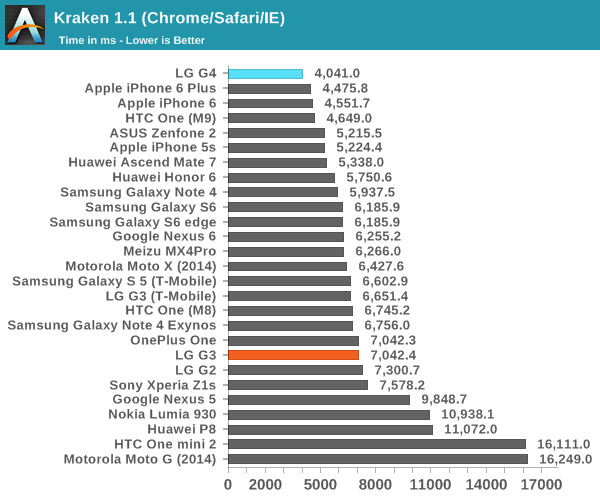
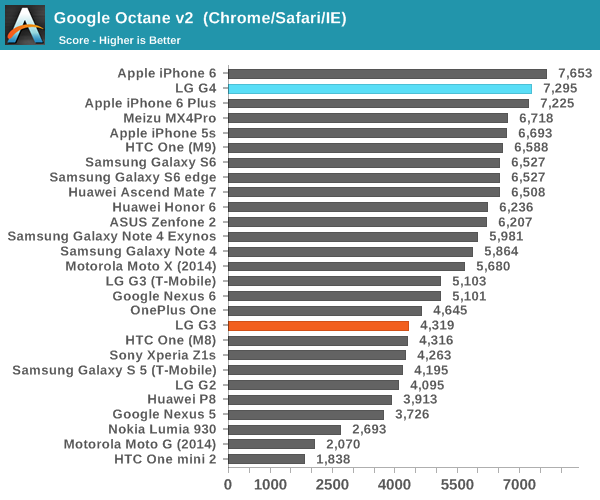
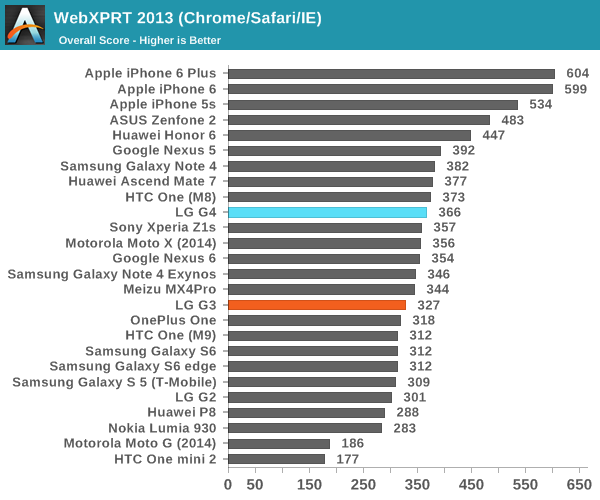
As we can see here, it looks like the combination of the Snapdragon 808 SoC and some work on LG/Qualcomm's part with optimizations for Chrome produces some pretty stunning results in Kraken and Octane. I suspect at least part of this is better optimization at the SoC level for the Cortex A57 in the Snapdragon 808/general software optimization, and at least partly optimizations designed to improve scores in those benchmarks as performance is noticeably more mixed in WebXPRT 2013. At any rate, web browsing performance is consistently good with the G4 and even intensive sites scroll smoothly.
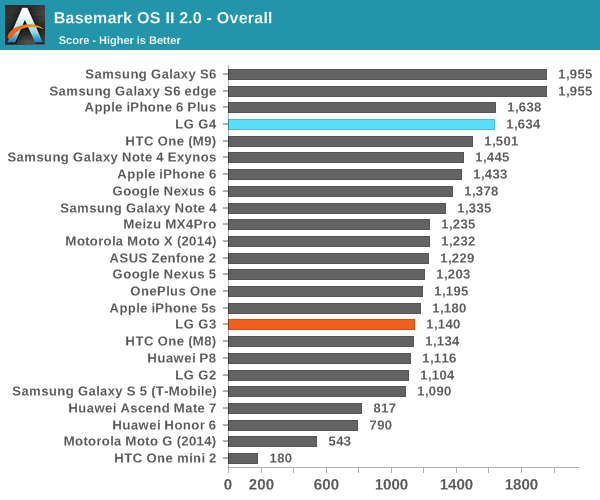
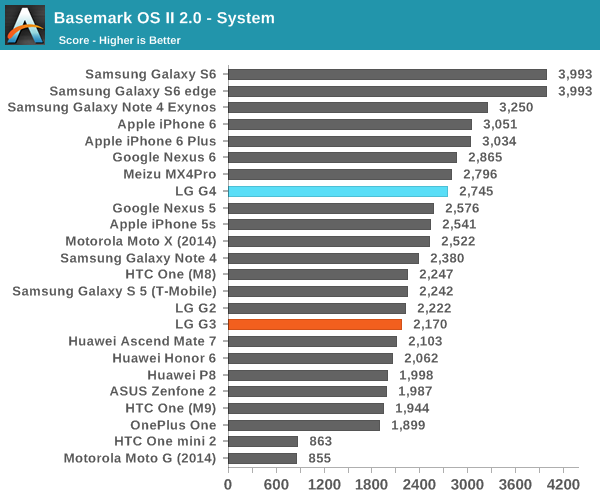
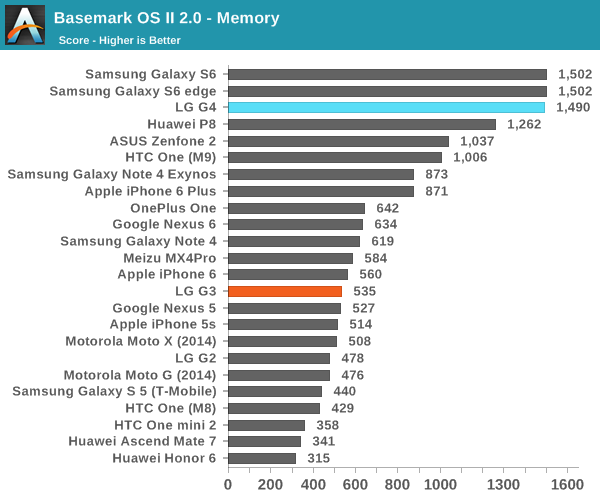
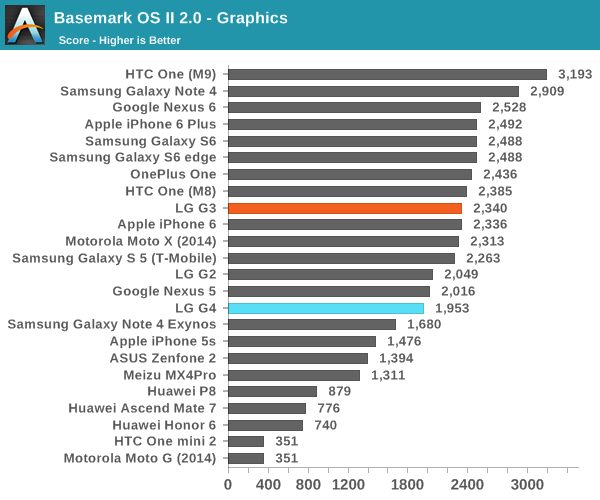
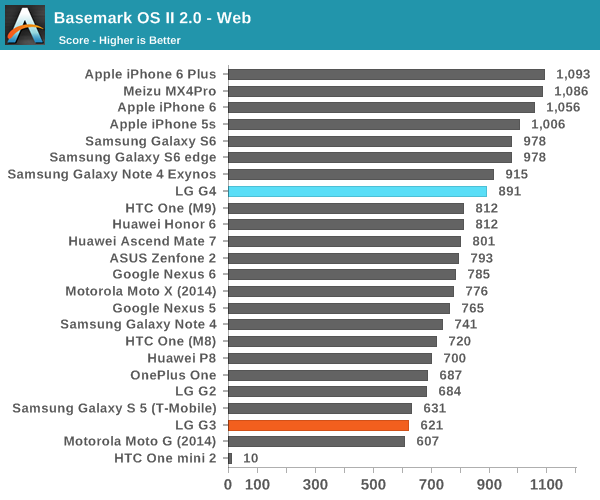
Once again, we see a noticeable performance uplift relative to the Snapdragon 810 devices that we've tested. It seems that LG has made a solid judgment call when they decided to use Snapdragon 808 instead of 810. However, despite this we see that the LG G4 trails behind the Galaxy S6 in terms of performance, which is due to the lower GPU score here which is closer to the Snapdragon 800 than Snapdragon 805.
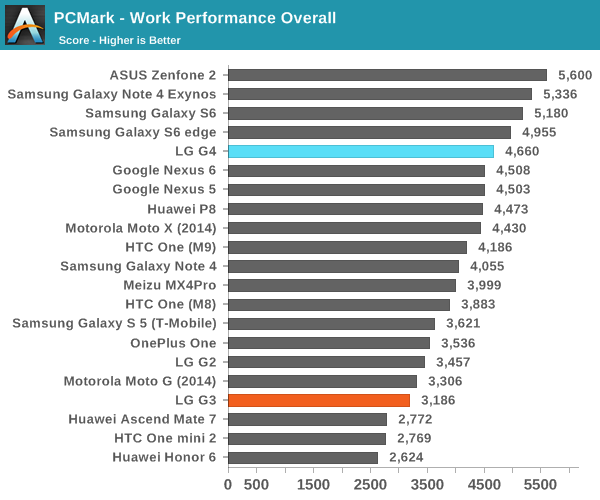
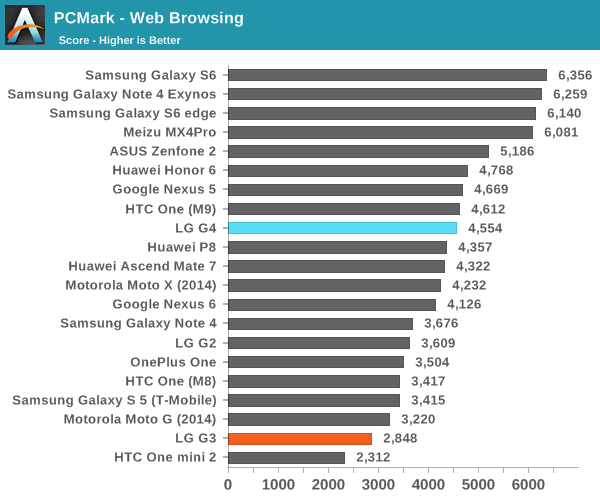
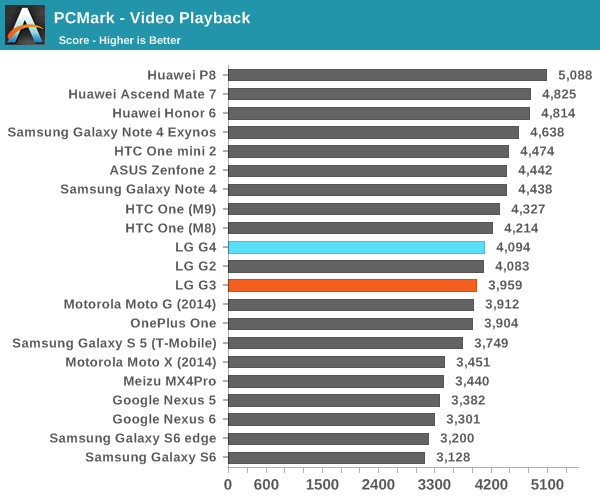
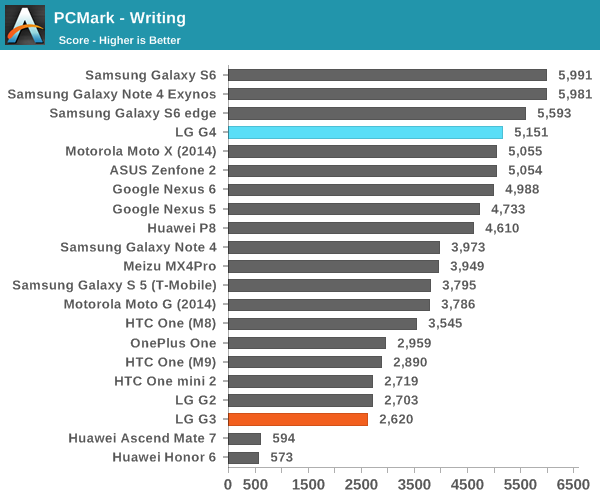
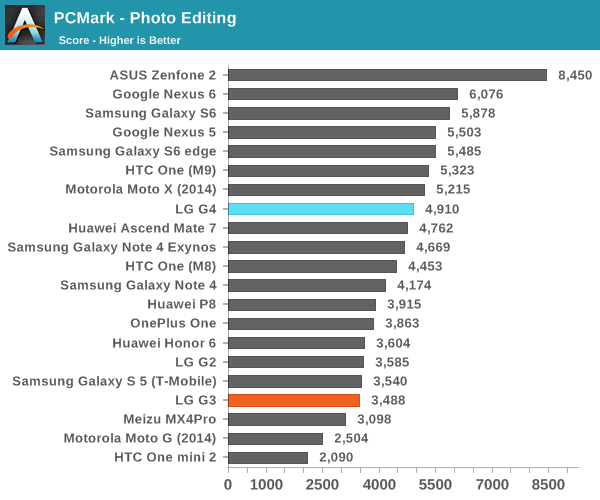
Once again, we see that the G4 performs quite strongly in these general purpose benchmarks, which to some extent affirms that more cores aren't necessarily better, as core count alone really fails to describe significant differences between SoCs. With a combination of the Snapdragon 808 SoC and better software optimization, it seems that LG has made a phone that can perform everyday tasks better than Snapdragon 810 devices, although it still falls short when compared to something like the Galaxy S6.










84 Comments
View All Comments
sonny73n - Friday, July 31, 2015 - link
Until this day, I still have no idea why they keep designing phones with display off-centered, speaker on the back, protruding camera and overkill display resolution. And these retarded engineers/designers are getting paid in millions. I know my opinion never matter but there one thing I can do is never to spend my money on any phone with any of the defects above. Let these arrogant idiots die out and hopefully someone else with common sense to take their place.Politic at work place is bad, LG. Keep having those retards design products for you and you'll lose more than just profit. 60% profit loss last time you say?
sonny73n - Friday, July 31, 2015 - link
Let me clarifyThe company reported a net profit of 226.4 billion won ($195 million) for the April-June quarter, compared with 411.8 billion won a year earlier. A FactSet survey of analysts forecast 204.8 billion won profit.
Sales fell 8 percent to 13.9 trillion won and operating income declined 60 percent to 244 billion won.
Maxpower2727 - Friday, July 31, 2015 - link
I assure you that their engineers and designers are not making millions of dollars.phoneasDAP - Friday, July 31, 2015 - link
I don't understand why websites don't evaluate headphone out quality. I don't think any site does.bug77 - Saturday, August 1, 2015 - link
gsmarena.com always does.Kildras - Friday, July 31, 2015 - link
I don't know how you call that camera performance equal /worse than Iphone 6plus.the day time photo is way sharper in both g4 and s6 while the iphone 6plus is filled by muddy details, just view the image in full resolution and tell me they are not far superior?
The difference is even bigger in night time photos, there is just no competition at all where iphone 6plus pretty much fail to capture to details and at least the g4 has some "leaves" shapes.
hari s - Saturday, August 1, 2015 - link
Not a good one at allhari s - Saturday, August 1, 2015 - link
I bought the lg G4 on july 1.on 29 july morning i couldnt switch the phone on.immediately i took it to the nearest lg service centre .they said it was problem with the mother board.may b my bad luck but is it affordable.after spending 50000 rs i didnt use the phone even for one month.boe - Monday, August 3, 2015 - link
The only benchmark I looked for was talk time as I use my phone everyday for my work phone where I give computer support. I didn't see a talk time benchmark - preferably with BT.ileben - Tuesday, August 4, 2015 - link
You guys should really start posting graphs of fps over time for a 20 minute run, so that we can get a good idea of performance degradation. Also the performance degradation chart values should be expressed as a ratio of [final run] / [cold run], otherwise it's pointless.